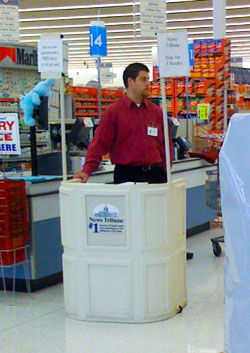Young woman (college age) scours flea markets looking for digital cameras and the occasional memory card. She uses the more interesting photos in her art projects. She finds a little point and shoot and buys it, even though she can’t seem to call up any photos.
Later that afternoon she gets the camera to turn on and finds just two photos. One is an amazingly realistic image of the World Trade Center Towers in mid-collapse. The date and time (the following morning) appear in the lower right-hand corner.
Gruesome, but damned good Photo Shop work. She emails it to an art school friend who is equally impressed. Can’t see how it’s done and he can ALWAYS see how it’s done. Really bugs him.
The next morning the world changes forever. She goes back to her apartment and calls up the image on her laptop. The same image she see from her apartment window. Whoa.
The phone rings and it’s her friend from art school.
“What the fuck!? Where did you get that picture? Where did you get a fucking picture of something before it happened.
[later at friends apartment]
Young Woman wants to take the photo to the police. Hold on, says Friend. How can you explain having that photo. No way, have to think this through. Was that the only photo on the camera, asks Friend?
Young Woman pulls up the other image. It’s a store front with a selection of cameras displayed. One is circled in red. But nothing to indicate where the shop might be.
[We’ll fast-forward a bit and assume they see a street sign or address in the reflection or something like that]
They buy the camera and jump back in the car to take a look. Again, two photos. One a disaster (make it as big and as bad as you like) with date and time stamp for a week from that day.
They have to figure out where the disaster is going to take place and how to stop it. I’ll bet real screenwriters have a name for this kind keep-the-plot-moving writing. This sequence repeats a few times with the girls preventing some and not others.
The final camera only has one photo. Of the Friend shooting Young Woman in the head with a large handgun.
Regular readers know that this is where I stall out. No ending. No way to wrap things up. That, class is your assignment. To the comments!
PS: This is only a little like a story idea I posted a couple of years ago.

 I almost didn’t post this because I don’t want to read anything into the photo. But this young man is soliciting subscribers to
I almost didn’t post this because I don’t want to read anything into the photo. But this young man is soliciting subscribers to